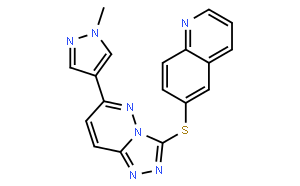
 COA COA |
 MSDS MSDS |
 HPLC HPLC |
 NMR NMR |
| CAS No: | 1022150-57-7 |
| Molecular formula(MF) | C18H13N7S |
| Molecular Weight(MW): | 359.41 |
| Alias |
| In vitro | DMSO | 3 mg/mL warmed (8.34 mM) |
|---|---|---|
| Water | <1 mg/mL | |
| Ethanol | <1 mg/mL | |
| In vivo | 0.5% methylcellulose+0.2% Tween 80 | 30 mg/mL |
| Description | SGX-523 is a selective Met inhibitor with IC50 of 4 nM, no activity to BRAFV599E, c-Raf, Abl and p38α. Phase 1. | |||||||||||
|---|---|---|---|---|---|---|---|---|---|---|---|---|
| Targets |
|
|||||||||||
| In vitro |
SGX-523 belongs to the class of c-Met/hepatocyte growth factor receptor (HGFR) tyrosine kinase inhibitors. SGX-523 stabilizes MET in a unique inactive conformation that is inaccessible to other protein kinases, suggesting an explanation for its selectivity. SGX523 potently inhibits the purified MET catalytic domain but not the closely related receptor tyrosine kinase RON. SGX523 indicates ATP-competitive inhibition with higher apparent affinity for the less active, unphosphorylated form of MET [MET-KD(0P), with a Ki of 2.7 nM] versus the more active phospho-enzyme [MET-KD(3P), with a Ki of 23 nM], a phenomenon consistent with preferential binding to an inactive enzyme conformation. SGX523 inhibits MET-mediated signaling, cell proliferation and cell migration at nanomolar concentrations but had no effect on signaling dependent on other protein kinases, including the closely related RON, even at micromolar concentrations.[1] |
|||||||||||
| In vivo | SGX523 significantly retards the growth of preestablished GTL16 tumors when administered orally at doses of ≥10 mg/kg twice daily. SGX523 potently inhibits U87MG tumor growth; at 30 mg/kg dosed twice daily, SGX523 leads to clear regression of U87MG tumors. SGX523, dosed twice daily at 30 mg/kg, also retards the growth of H441 tumors with concomitant reduction in tumor MET autophosphorylation levels. SGX523 inhibition of MET in vivo is associated with the dose-dependent inhibition of growth of tumor xenografts derived from human glioblastoma, lung and gastric cancers, confirming the dependence of these tumors on MET catalytic activity. [1] |